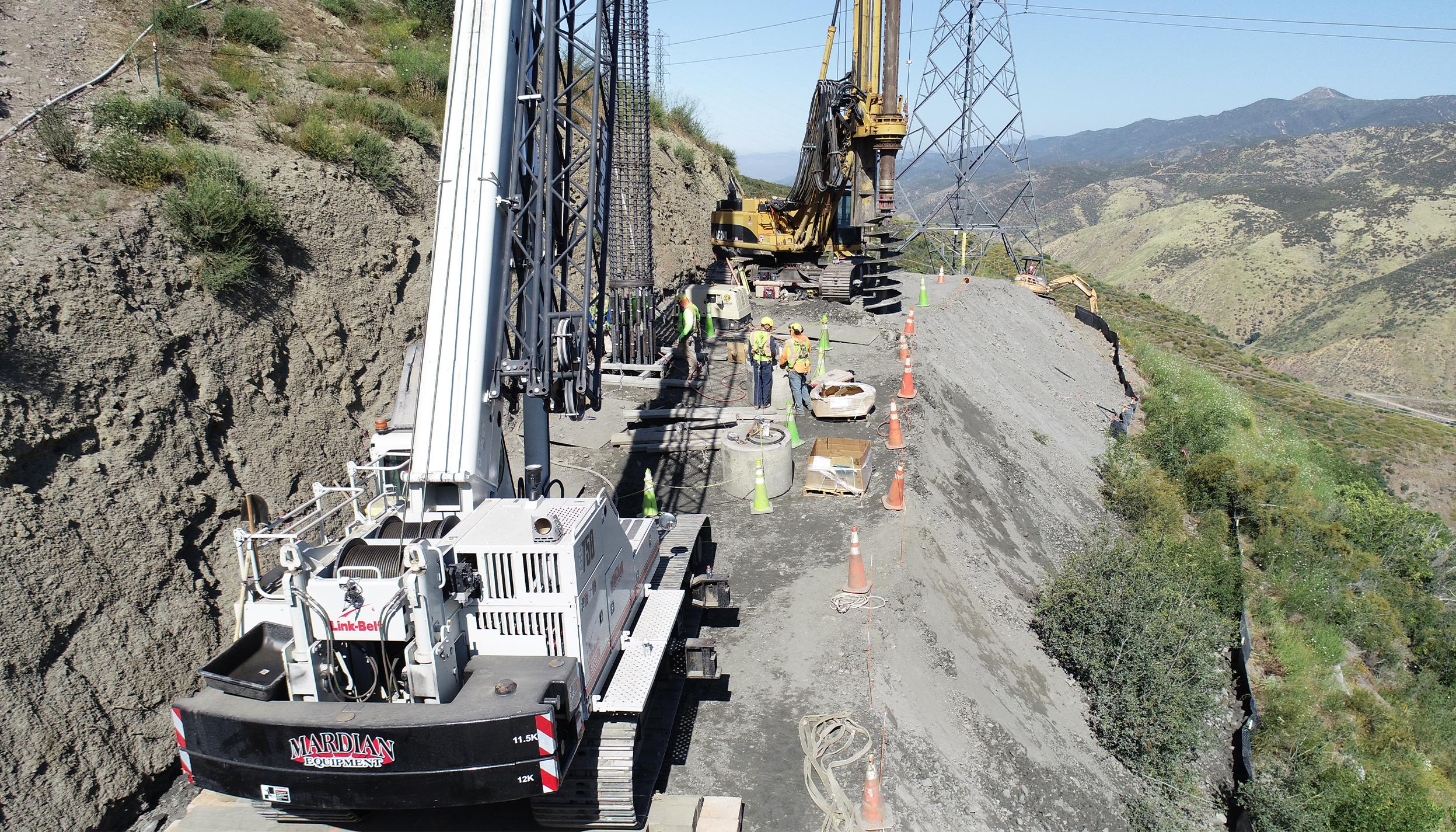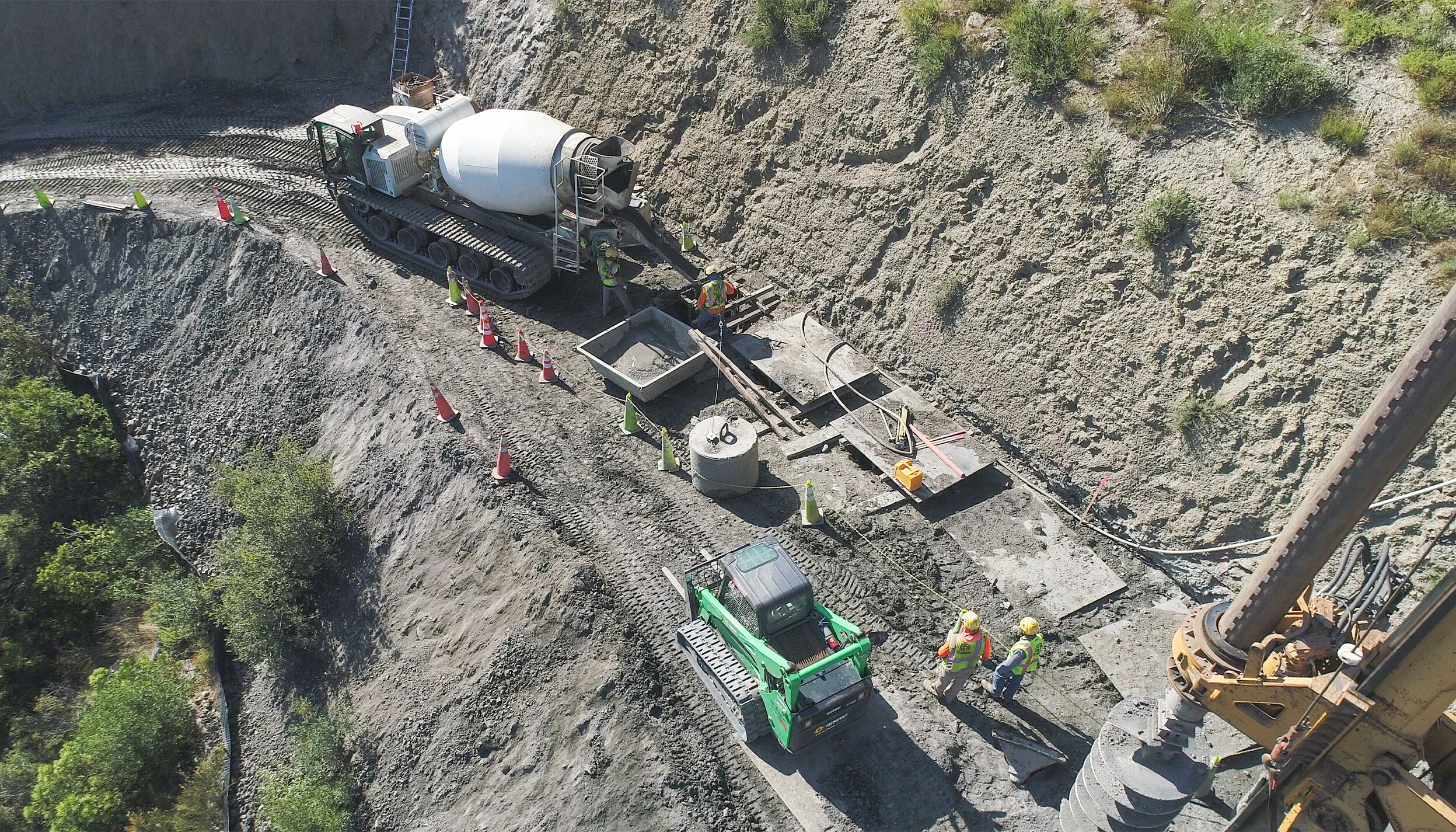The following article was the Feature Story in the May/June 2021 Edition of ADSC’s Foundation Drilling Magazine.
The Barren Ridge Renewable Energy Transmission Project is part of a plan that taps into the sources found within the Tehachapi Mountains and the Mojave Desert, known for being an excellent source of solar power. This project brings renewable energy from these sources through 62 miles of newly constructed 230kV double and triple circuit transmission lines.
Due to the mountain-side location of this energy superhighway, access was tight with challenging terrain. The route fell within or directly adjacent to utility corridors and paralleled existing transmission lines. As a partner on this EPC project, Aldridge was contracted to help restore the existing cut slopes to their previous condition to allow access to the site. Aldridge performed installation of Cast-In-Drilled-Holes (CIDH) piles along the access road in order to stabilize the roadway by utilizing compacted fill slopes.
NAVIGATING MOUNTAINOUS TERRAIN
Aldridge routinely performs work all across the country in a wide range of terrains and working conditions. However, the Barren Ridge Project provided logistical intricacies associated with its location through a national forest. As with every job, Aldridge brought their innovative strategy, in-depth focus on pre-planning, and daily attention to safety and quality to successfully complete this project.
This was an extremely unique job due to the location. From the bottom to the top of the site, there was a 1400 FT elevation change, making the transportation of the needed concrete from Point A to Point B a major challenge.
Aldridge was up to that challenge. Crews performed the installation of CIDH piles along the access road between two towers. This access road was approximately 1,100’ long and required the installation of 120 CIDH piles ranging from 2' x 20’ to 4' x 60'.
Standard concrete equipment was unable to navigate this difficult terrain and so it was up to Aldridge’s innovation and team coordination to make this a successful project. The team devised a plan to use specialty equipment to allow for the concrete to reach its intended locations.
Extensive planning between the project team and concrete suppliers was required to execute the plan. In order to combat the steep mountain side locations, the concrete trucks were backed onto a ramp that Aldridge set up at the base of the mountain. Then, ready mix trucks transferred the concrete to the Prinoth Panther Rubber Track Concrete mixer and two loaders with concrete buckets attached to forks. This complex concrete moving operation went from the bottom of the hill up through the switchbacks and up the mountain. Upon reaching the intended location, the concrete was either directly poured into the hole or transferred into a pump to get the material up the side of the mountain and into the holes.
Since this process ultimately required a longer time frame than traditional pours, Aldridge project management had to revise the work schedule to accommodate this workflow. Despite these schedule changes, the project remained on its intended schedule throughout the course of the project lifespan.
COMPANY-WIDE COMMITMENT TO SAFETY
At Aldridge, Safety is a core value. All Aldridge projects follow the company culture of being IIF - Incident and Injury Free. This culture-changing journey is an organizational investment toward excellence in safety and is a mindset intolerant of any level, frequency, or severity of incident or injury. In this environment, safety is value-based. Aldridge brings their safety culture into every project.
Utilizing a site-specific safety plan, the project team can identify and address project-specific risks and hazards. Some of the highlights of the plan for the Barren Ridge Project included special coordination with emergency services, communication guidelines, and weather hazard awareness.
Dust and potential fire hazards were universal in this desert and mountainous location. To avoid an incident, water was staged throughout the work site with folding tanks made available for fire and dust suppression. Additionally, there was special coordination with the local fire departments and emergency service providers since there was little to no cell service at that high elevation. As an extra precaution, Aldridge was provided with an emergency rescue beacon for air rescue in the event of an emergency.
To combat the challenge of no cell phone service, every employee, general contractor, and subcontractor had two-way radios on the same frequency to be able to communicate. Special escort access was granted for deliveries and visitors, coordinating meeting locations at a staging location prior to entering the work area. With the radio system in place, there was never anyone on the worksite who was unreachable.
Making your way up to the work site included climbing to 1400 FT elevation and many sharp turns through the mountainside. Since there were sharp turns and limited sight around the bend, each turn was marked with a numbered marker. The use of this marker system allowed for safer and easier access to reach various work sites. For example, when the all-terrain concrete mixer and loaders would arrive, each loader had constant radio communication on its position relative to the turn marker.
Since the project timeline spanned over the hottest summer months, Aldridge’s Heat Stress Prevention Program was strictly followed. Before the start of work each day, Aldridge crew leaders hold a job briefing to go over the daily task analysis (DTA). Outlined in the DTA is a review of the immediate tasks as well as identified risks and controls required to safely complete those tasks. For this project, that included providing information on heat-related illness and allowing for additional breaks, access to cool drinking water and a cooling site, and extra monitoring by a field leader who is First Aid/CPR certified.
Everyone at Aldridge has a duty to themselves and to their co-workers to be constantly aware of potentially hazardous conditions and act when such conditions are identified. Each employee has Stop Work Authority, which means that it is everyone’s responsibility to speak up and even stop a project if there is a safety concern. Aldridge is proud to report that there were no recordable incidents during this project.
Steven Belanger, Aldridge Regional Safety Manager, had this to say,
“The Barren Ridge team did a great job analyzing the difficult terrain; they were savvy with new equipment, new material handling methods to get cages into difficult locations. They put the plan together and followed it. On-site you could tell the plan was communicated and the crew was performing the tasks they were instructed to do. Planning was pivotal for the safety and completion of the project. As a safety professional, it's great to see the basics being utilized effectively.”
The Barren Ridge Renewable Energy project provided an opportunity for Aldridge to showcase the skills and knowledge that make them a leader in foundation work. No matter the constraints, it's in Aldridge’s DNA to always find an innovative solution to complex foundation projects.
TEAM RECOGNITION
Nick Cullen - Division Manager
Sia Tumari - Project Manager
Steve Belanger - Regional Safety Manager
Steve Babiarz - General Operations Manager
Butch Rush - General Superintendent
Brandon Abbate - Superintendent
Ben Brown - Groundman
Patrick Mueller - Equipment Operator
Mark Olson - Equipment Operator
John Hauser - Pour Lead







